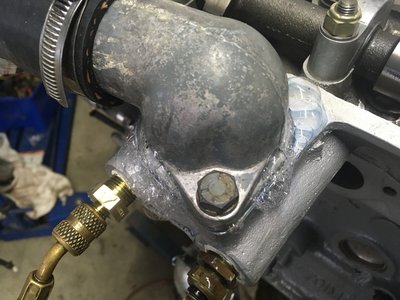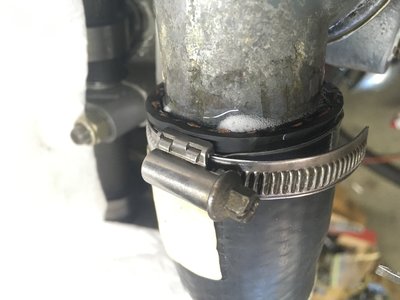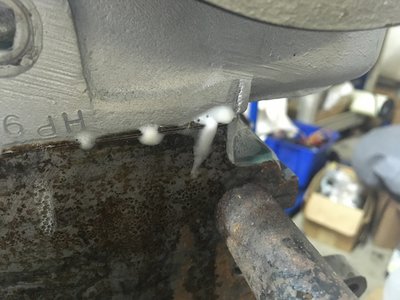Pressure-Testing The Engine: How Good Should It Be?
Over the past several months, I have carefully reassembled my newly-rebuilt twin-cam engine using the cartridge-style water pump and timing covers from Dave Bean Engineering (which is a story in itself). I've been advised to pressure-test the cooling system to be certain that it holds pressure prior to dropping it in the car. To do that, I:
--Sealed up the water pump and thermostat holes with a hose, a rubber cork, and hose clamps.
--Re-inserted the temperature sender.
--Found an adapter that threads into the hole for the heater valve and adapts it to the fitting for an air conditioning gauge set so I can pressure-test it using a nitrogen bottle.
I do a lot of a/c work, so I'm very accustomed to pressure-testing, peeling the layers of the onion so to speak, finding leaks, fixing them, and achieving the goal of the system not bubbling anywhere when soap solution is sprayed (I use "Big Blu"), holding some set amount of pressure overnight, and not leaking a single PSI. I'm trying to do that here, to reach the point where it can old 20 PSI and not drop at all. As part of this process:
--I found that the threaded neck and threaded plug of the Bean cover were both leaking slightly. I disassembled them and sealed them up, one with Yamabond4 and the other with Permatex Seal+Lock.
--I found that the thermostat neck was leaking due to some corrosion at the flange. I repaired it with epoxy, sanded it, and re-gasketed it and sealed it with Aviation Form-A-Gasket. Below is an example of the big obvious bubbles from this kind of a big obvious leak.
--I found that the temperature sensor was leaking slightly and sealed the threads with Yamabond4.
In doing these things, I've now reached the point where I can pressurize it to 20 PSI, spray soap solution at every flange, seam, and thread, and not see it actively blowing any bubbles or see the pressure drop on the gauge while I'm watching it. Perhaps most importantly, I'm not seeing any bubbles being blown from the interface between the block and backplate, the backplate and outer timing cover, or around the cartridge-style water pump.
If you're waiting for a "however," you're right. There is a "however."
However, if I wait and watch the pressure gauge, the pressure drops by about 2 PSI in about 30 minutes, and if I look very carefully at the sprayed soap solution, I can see some clustering of tiny bubbles (they look like little insect egg cases) in a few places. This kind of clustering is what you learn to look for in a/c work in order to detect very small slow leaks. One place I see them is at the hose connection to the thermostat. That's no big deal; I can re-seal it with a different clamp, and even if it leaks a drop of coolant there, I don't really care. Below is a photo of the tiny bubbles coming from this attached hose.
But if I admit that that's a cluster of bubbles, I have to admit that I see some similar clusters of bubbles at the back of the block at the head gasket. The photo is below.
Note that the block was decked and the head was milled. The head gasket is a layered copper gasket coated with Wellseal as per Miles Wilkins' book and torqued down to spec.
So, while I'd prefer that I test this the way I test a/c systems and reach the point where there's ZERO leakage overnight, have I reached the point where it's good enough? Is it likely that, if there is a small coolant pressure leak through the head gasket, that it'll seal up when the engine heat-cycles a few times?
Thanks.
--Rob Siegel
--Sealed up the water pump and thermostat holes with a hose, a rubber cork, and hose clamps.
--Re-inserted the temperature sender.
--Found an adapter that threads into the hole for the heater valve and adapts it to the fitting for an air conditioning gauge set so I can pressure-test it using a nitrogen bottle.
I do a lot of a/c work, so I'm very accustomed to pressure-testing, peeling the layers of the onion so to speak, finding leaks, fixing them, and achieving the goal of the system not bubbling anywhere when soap solution is sprayed (I use "Big Blu"), holding some set amount of pressure overnight, and not leaking a single PSI. I'm trying to do that here, to reach the point where it can old 20 PSI and not drop at all. As part of this process:
--I found that the threaded neck and threaded plug of the Bean cover were both leaking slightly. I disassembled them and sealed them up, one with Yamabond4 and the other with Permatex Seal+Lock.
--I found that the thermostat neck was leaking due to some corrosion at the flange. I repaired it with epoxy, sanded it, and re-gasketed it and sealed it with Aviation Form-A-Gasket. Below is an example of the big obvious bubbles from this kind of a big obvious leak.
--I found that the temperature sensor was leaking slightly and sealed the threads with Yamabond4.
In doing these things, I've now reached the point where I can pressurize it to 20 PSI, spray soap solution at every flange, seam, and thread, and not see it actively blowing any bubbles or see the pressure drop on the gauge while I'm watching it. Perhaps most importantly, I'm not seeing any bubbles being blown from the interface between the block and backplate, the backplate and outer timing cover, or around the cartridge-style water pump.
If you're waiting for a "however," you're right. There is a "however."
However, if I wait and watch the pressure gauge, the pressure drops by about 2 PSI in about 30 minutes, and if I look very carefully at the sprayed soap solution, I can see some clustering of tiny bubbles (they look like little insect egg cases) in a few places. This kind of clustering is what you learn to look for in a/c work in order to detect very small slow leaks. One place I see them is at the hose connection to the thermostat. That's no big deal; I can re-seal it with a different clamp, and even if it leaks a drop of coolant there, I don't really care. Below is a photo of the tiny bubbles coming from this attached hose.
But if I admit that that's a cluster of bubbles, I have to admit that I see some similar clusters of bubbles at the back of the block at the head gasket. The photo is below.
Note that the block was decked and the head was milled. The head gasket is a layered copper gasket coated with Wellseal as per Miles Wilkins' book and torqued down to spec.
So, while I'd prefer that I test this the way I test a/c systems and reach the point where there's ZERO leakage overnight, have I reached the point where it's good enough? Is it likely that, if there is a small coolant pressure leak through the head gasket, that it'll seal up when the engine heat-cycles a few times?
Thanks.
--Rob Siegel


